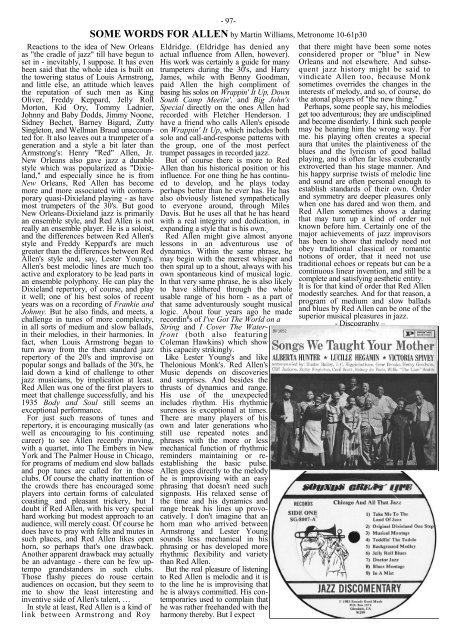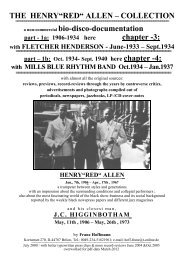Red Allen Chapters 9 - The Jazz Archive
Red Allen Chapters 9 - The Jazz Archive
Red Allen Chapters 9 - The Jazz Archive
Create successful ePaper yourself
Turn your PDF publications into a flip-book with our unique Google optimized e-Paper software.
Reactions to the idea of New Orleans<br />
as "the cradle of jazz" till have begun to<br />
set in - inevitably, I suppose. It has even<br />
been said that the whole idea is built on<br />
the towering status of Louis Armstrong,<br />
and little else, an attitude which leaves<br />
the reputation of such men as King<br />
Oliver, Freddy Keppard, Jelly Roll<br />
Morton, Kid Ory, Tommy Ladnier,<br />
Johnny and Baby Dodds, Jimmy Noone,<br />
Sidney Bechet, Barney Bigard, Zutty<br />
Singleton, and Wellman Braud unaccounted<br />
for. It also leaves out a trumpeter of a<br />
generation and a style a bit later than<br />
Armstrong's: Henry "<strong>Red</strong>" <strong>Allen</strong>, Jr.<br />
New Orleans also gave jazz a durable<br />
style which was popularized as "Dixieland,"<br />
and especially since he is from<br />
New Orleans, <strong>Red</strong> <strong>Allen</strong> has become<br />
more and more associated with contemporary<br />
quasi-Dixieland playing - as have<br />
most trumpeters of the 30's. But good<br />
New Orleans-Dixieland jazz is primarily<br />
an ensemble style, and <strong>Red</strong> <strong>Allen</strong> is not<br />
really an ensemble player. He is a soloist,<br />
and the differences between <strong>Red</strong> <strong>Allen</strong>'s<br />
style and Freddy Keppard's are much<br />
greater than the differences between <strong>Red</strong><br />
<strong>Allen</strong>'s style and, say, Lester Young's.<br />
<strong>Allen</strong>'s best melodic lines are much too<br />
active and exploratory to be lead parts in<br />
an ensemble polyphony. He can play the<br />
Dixieland repertory, of course, and play<br />
it well; one of his best solos of recent<br />
years was on a recording of Frankie and<br />
Johnny. But he also finds, and meets, a<br />
challenge in tunes of more complexity,<br />
in all sorts of medium and slow ballads,<br />
in their melodies, in their harmonies. In<br />
fact, when Louis Armstrong began to<br />
turn away from the then standard jazz<br />
repertory of the 20's and improvise on<br />
popular songs and ballads of the 30's, he<br />
laid down a kind of challenge to other<br />
jazz musicians, by implication at least.<br />
<strong>Red</strong> <strong>Allen</strong> was one of the first players to<br />
meet that challenge successfully, and his<br />
1935 Body and Soul still seems an<br />
exceptional performance.<br />
For just such reasons of tunes and<br />
repertory, it is encouraging musically (as<br />
well as encouraging to his continuing<br />
career) to see <strong>Allen</strong> recently moving,<br />
with a quartet, into <strong>The</strong> Embers in New<br />
York and <strong>The</strong> Palmer House in Chicago,<br />
for programs of medium end slow ballads<br />
and pop tunes are called for in those<br />
clubs. Of course the chatty inattention of<br />
the crowds there has encouraged some<br />
players into certain forms of calculated<br />
coasting, and pleasant trickery, but I<br />
doubt if <strong>Red</strong> <strong>Allen</strong>, with his very special<br />
hard working but modest approach to an<br />
audience, will merely coast. Of course he<br />
does have to pray with felts and mutes in<br />
such places, and <strong>Red</strong> <strong>Allen</strong> likes open<br />
horn, so perhaps that's one drawback.<br />
Another apparent drawback may actually<br />
be an advantage - there can be few uptempo<br />
grandstanders in such clubs.<br />
Those flashy pieces do rouse certain<br />
audiences on occasion, but they seem to<br />
me to show the least interesting and<br />
inventive side of <strong>Allen</strong>'s talent, …<br />
In style at least, <strong>Red</strong> <strong>Allen</strong> is a kind of<br />
link between Armstrong and Roy<br />
- 97-<br />
SOME WORDS FOR ALLEN by Martin Williams, Metronome 10-61p30<br />
Eldridge. (Eldridge has denied any<br />
actual influence from <strong>Allen</strong>, however).<br />
His work was certainly a guide for many<br />
trumpeters during the 30's, and Harry<br />
James, while with Benny Goodman,<br />
paid <strong>Allen</strong> the high compliment of<br />
basing his solos on Wrappin' It Up, Down<br />
South Camp Meetin', and Big John's<br />
Special directly on the ones <strong>Allen</strong> had<br />
recorded with Fletcher Henderson. I<br />
have a friend who calls <strong>Allen</strong>'s episode<br />
on Wrappin' It Up, which includes both<br />
solo and call-and-response patterns with<br />
the group, one of the most perfect<br />
trumpet passages in recorded jazz.<br />
But of course there is more to <strong>Red</strong><br />
<strong>Allen</strong> than his historical position or his<br />
influence. For one thing he has continued<br />
to develop, and he plays today<br />
perhaps better than he ever has. He has<br />
also obviously listened sympathetically<br />
to everyone around, through Miles<br />
Davis. But he uses all that he has heard<br />
with a real integrity and dedication, in<br />
expanding a style that is his own.<br />
<strong>Red</strong> <strong>Allen</strong> might give almost anyone<br />
lessons in an adventurous use of<br />
dynamics. Within the same phrase, he<br />
may begin with the merest whisper and<br />
then spiral up to a shout, always with his<br />
own spontaneous kind of musical logic.<br />
In that very same phrase, he is also likely<br />
to have slithered through the whole<br />
usable range of his horn - as a part of<br />
that same adventurously sought musical<br />
logic. About four years ago he made<br />
recordin g s of I've Got <strong>The</strong> World on a<br />
String and I Cover <strong>The</strong> Waterfront<br />
(both also featuring<br />
Coleman Hawkins) which show<br />
this capacity strikingly.<br />
Like Lester Young's and like<br />
<strong>The</strong>lonious Monk's. <strong>Red</strong> <strong>Allen</strong>'s<br />
Music depends on discoveries<br />
and surprises. And besides the<br />
thrusts of dynamics and range.<br />
His use of the unexpected<br />
includes rhythm. His rhythmic<br />
sureness is exceptional at times.<br />
<strong>The</strong>re are many players of his<br />
own and later generations who<br />
still use repeated notes and<br />
phrases with the more or less<br />
mechanical function of rhythmic<br />
reminders maintaining or reestablishing<br />
the basic pulse.<br />
<strong>Allen</strong> goes directly to the melody<br />
he is improvising with an easy<br />
phrasing that doesn't need such<br />
signposts. His relaxed sense of<br />
the time and his dynamics and<br />
range break his lines up provocatively.<br />
I don't imagine that an<br />
horn man who arrived between<br />
Armstrong and Lester Young<br />
sounds less mechanical in his<br />
phrasing or has developed more<br />
rhythmic flexibility and variety<br />
than <strong>Red</strong> <strong>Allen</strong>.<br />
But the real pleasure of listening<br />
to <strong>Red</strong> <strong>Allen</strong> is melodic and it is<br />
to the line he is improvising that<br />
he is always committed. His contemporaries<br />
used to complain that<br />
he was rather freehanded with the<br />
harmony thereby. But I expect<br />
that there might have been some notes<br />
considered proper or "blue" in New<br />
Orleans and not elsewhere. And subsequent<br />
jazz history might be said to<br />
vindicate <strong>Allen</strong> too, because Monk<br />
sometimes overrides the changes in the<br />
interests of melody, and so, of course, do<br />
the atonal players of "the new thing."<br />
Perhaps, some people say, his melodies<br />
get too adventurous; they are undisciplined<br />
and become disorderly. I think such people<br />
may be hearing him the wrong way. For<br />
me. his playing often creates a special<br />
aura that unites the plaintiveness of the<br />
blues and the lyricism of good ballad<br />
playing, and is often far less exuberantly<br />
extroverted than his stage manner. And<br />
his happy surprise twists of melodic line<br />
and sound are often personal enough to<br />
establish standards of their own. Order<br />
and symmetry are deeper pleasures only<br />
when one has dared and won them. and<br />
<strong>Red</strong> <strong>Allen</strong> sometimes shows a daring<br />
that may turn up a kind of order not<br />
known before him. Certainly one of the<br />
major achievements of jazz improvisors<br />
has been to show that melody need not<br />
obey traditional classical or romantic<br />
notions of order, that it need not use<br />
traditional echoes or repeats but can be a<br />
continuous linear invention, and still be a<br />
complete and satisfying aesthetic entity.<br />
It is for that kind of order that <strong>Red</strong> <strong>Allen</strong><br />
modestly searches. And for that reason, a<br />
program of medium and slow ballads<br />
and blues by <strong>Red</strong> <strong>Allen</strong> can be one of the<br />
superior musical pleasures in jazz.<br />
- Discography –



